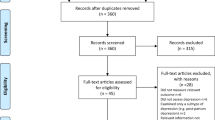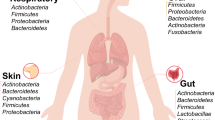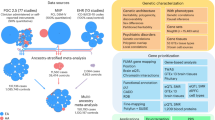Abstract
Major depressive disorder (MDD) is the result of complex gene–environment interactions. According to the World Health Organization, MDD is the leading cause of disability worldwide, and it is a major contributor to the overall global burden of disease. However, the definitive environmental mechanisms underlying the pathophysiology of MDD remain elusive. The gut microbiome is an increasingly recognized environmental factor that can shape the brain through the microbiota-gut-brain axis. We show here that the absence of gut microbiota in germ-free (GF) mice resulted in decreased immobility time in the forced swimming test relative to conventionally raised healthy control mice. Moreover, from clinical sampling, the gut microbiotic compositions of MDD patients and healthy controls were significantly different with MDD patients characterized by significant changes in the relative abundance of Firmicutes, Actinobacteria and Bacteroidetes. Fecal microbiota transplantation of GF mice with ‘depression microbiota’ derived from MDD patients resulted in depression-like behaviors compared with colonization with ‘healthy microbiota’ derived from healthy control individuals. Mice harboring ‘depression microbiota’ primarily exhibited disturbances of microbial genes and host metabolites involved in carbohydrate and amino acid metabolism. This study demonstrates that dysbiosis of the gut microbiome may have a causal role in the development of depressive-like behaviors, in a pathway that is mediated through the host’s metabolism.
This is a preview of subscription content, access via your institution
Access options
Subscribe to this journal
Receive 12 print issues and online access
$259.00 per year
only $21.58 per issue
Buy this article
- Purchase on Springer Link
- Instant access to full article PDF
Prices may be subject to local taxes which are calculated during checkout




Similar content being viewed by others
References
Mitchell AJ, Chan M, Bhatti H, Halton M, Grassi L, Johansen C et al. Prevalence of depression, anxiety, and adjustment disorder in oncological, haematological, and palliative-care settings: a meta-analysis of 94 interview-based studies. Lancet Oncol 2011; 12: 160–174.
Simon GE . Social and economic burden of mood disorders. Biol Psychiatry 2003; 54: 208–215.
Luscher B, Shen Q, Sahir N . The GABAergic deficit hypothesis of major depressive disorder. Mol Psychiatry 2011; 16: 383–406.
Guilloux J-P, Douillard-Guilloux G, Kota R, Wang X, Gardier A, Martinowich K et al. Molecular evidence for BDNF- and GABA-related dysfunctions in the amygdala of female subjects with major depression. Mol Psychiatry 2012; 17: 1130–1142.
Müller N, Schwarz M . The immune-mediated alteration of serotonin and glutamate: towards an integrated view of depression. Mol Psychiatry 2007; 12: 988–1000.
Schlösser RG, Wagner G, Koch K, Dahnke R, Reichenbach JR, Sauer H . Fronto-cingulate effective connectivity in major depression: a study with fMRI and dynamic causal modeling. Neuroimage 2008; 43: 645–655.
Zheng P, Gao HC, Li Q, Shao WH, Zhang ML, Cheng K et al. Plasma metabonomics as a novel diagnostic approach for major depressive disorder. J Proteome Res 2012; 11: 1741–1748.
Zheng P, Chen J-J, Huang T, Wang M-J, Wang Y, Dong M-X et al. A novel urinary metabolite signature for diagnosing major depressive disorder. J Proteome Res 2013; 12: 5904–5911.
Zheng P, Wang Y, Chen L, Yang D, Meng H, Zhou D et al. Identification and validation of urinary metabolite biomarkers for major depressive disorder. Mol Cell Proteomics 2013; 12: 207–214.
Chen J-J, Zhou C-J, Liu Z, Fu Y-Y, Zheng P, Yang D-Y et al. Divergent urinary metabolic phenotypes between major depressive disorder and bipolar disorder identified by a combined GC–MS and NMR spectroscopic metabonomic approach. J Proteome Res 2015; 14: 3382–3389.
Naseribafrouei A, Hestad K, Avershina E, Sekelja M, Linløkken A, Wilson R et al. Correlation between the human fecal microbiota and depression. Neurogastroenterol Motil 2014; 26: 1155–1162.
Jiang H, Ling Z, Zhang Y, Mao H, Ma Z, Yin Y et al. Altered fecal microbiota composition in patients with major depressive disorder. Brain Behav Immun 2015; 48: 186–194.
Park A, Collins J, Blennerhassett P, Ghia J, Verdu E, Bercik P et al. Altered colonic function and microbiota profile in a mouse model of chronic depression. Neurogastroenterol Motil 2013; 25: 733–e575.
Clemente JC, Ursell LK, Parfrey LW, Knight R . The impact of the gut microbiota on human health: an integrative view. Cell 2012; 148: 1258–1270.
Henao-Mejia J, Elinav E, Jin C, Hao L, Mehal WZ, Strowig T et al. Inflammasome-mediated dysbiosis regulates progression of NAFLD and obesity. Nature 2012; 482: 179–185.
Koren O, Goodrich JK, Cullender TC, Spor A, Laitinen K, Bäckhed HK et al. Host remodeling of the gut microbiome and metabolic changes during pregnancy. Cell 2012; 150: 470–480.
Konstantinov SR, Peppelenbosch MP . Fecal microbiota transfer may increase irritable bowel syndrome and inflammatory bowel diseases–associated bacteria. Gastroenterology 2013; 144: e19–e20.
Wen L, Ley RE, Volchkov PY, Stranges PB, Avanesyan L, Stonebraker AC et al. Innate immunity and intestinal microbiota in the development of Type 1 diabetes. Nature 2008; 455: 1109–1113.
Ridaura VK, Faith JJ, Rey FE, Cheng J, Duncan AE, Kau AL et al. Gut microbiota from twins discordant for obesity modulate metabolism in mice. Science 2013; 341: 1241214.
Bercik P, Denou E, Collins J, Jackson W, Lu J, Jury J et al. The intestinal microbiota affect central levels of brain-derived neurotropic factor and behavior in mice. Gastroenterology 2011; 141: 599–609.e593.
Clarke G, Grenham S, Scully P, Fitzgerald P, Moloney R, Shanahan F et al. The microbiome-gut-brain axis during early life regulates the hippocampal serotonergic system in a sex-dependent manner. Mol Psychiatry 2013; 18: 666–673.
Heijtz RD, Wang S, Anuar F, Qian Y, Björkholm B, Samuelsson A et al. Normal gut microbiota modulates brain development and behavior. Proc Natl Acad Sci USA 2011; 108: 3047–3052.
Neufeld K, Kang N, Bienenstock J, Foster J . Reduced anxiety‐like behavior and central neurochemical change in germ‐free mice. Neurogastroenterol Motil 2011; 23: 255–e119.
Cryan JF, Dinan TG . Mind-altering microorganisms: the impact of the gut microbiota on brain and behaviour. Nat Rev Neurosci 2012; 13: 701–712.
Gareau MG, Wine E, Rodrigues DM, Cho JH, Whary MT, Philpott DJ et al. Bacterial infection causes stress-induced memory dysfunction in mice. Gut 2010; 60: 307–317, gut. 2009.202515.
Desbonnet L, Clarke G, Shanahan F, Dinan T, Cryan J . Microbiota is essential for social development in the mouse. Mol Psychiatry 2014; 19: 146.
Hsiao EY, McBride SW, Hsien S, Sharon G, Hyde ER, McCue T et al. Microbiota modulate behavioral and physiological abnormalities associated with neurodevelopmental disorders. Cell 2013; 155: 1451–1463.
Yang D, Li Q, Fang L, Cheng K, Zhang R, Zheng P et al. Reduced neurogenesis and pre-synaptic dysfunction in the olfactory bulb of a rat model of depression. Neuroscience 2011; 192: 609–618.
Kim CS, Chang PY, Johnston D . Enhancement of dorsal hippocampal activity by knockdown of HCN1 channels leads to anxiolytic-and antidepressant-like behaviors. Neuron 2012; 75: 503–516.
Sadakata T, Shinoda Y, Oka M, Sekine Y, Sato Y, Saruta C et al. Reduced axonal localization of a Caps2 splice variant impairs axonal release of BDNF and causes autistic-like behavior in mice. Proc Natl Acad Sci USA 2012; 109: 21104–21109.
Crupi R, Cambiaghi M, Spatz L, Hen R, Thorn M, Friedman E et al. Reduced adult neurogenesis and altered emotional behaviors in autoimmune-prone B-cell activating factor transgenic mice. Biol Psychiatry 2010; 67: 558–566.
Oury F, Khrimian L, Denny CA, Gardin A, Chamouni A, Goeden N et al. Maternal and offspring pools of osteocalcin influence brain development and functions. Cell 2013; 155: 228–241.
American Psychiatric Association Diagnostic and Statistical Manual of Mental Disorders (Text Revision). American Psychiatric Association: Washington, DC, USA, 2000.
Potts MK, Daniels M, Burnam MA, Wells KB . A structured interview version of the Hamilton Depression Rating Scale: evidence of reliability and versatility of administration. J Psychiatr Res 1990; 24: 335–350.
Tamaki H, Wright CL, Li X, Lin Q, Hwang C, Wang S et al. Analysis of 16 S rRNA amplicon sequencing options on the Roche/454 next-generation titanium sequencing platform. PloS One 2011; 6: e25263.
Bruce-Keller AJ, Salbaum JM, Luo M, Blanchard E, Taylor CM, Welsh DA et al. Obese-type gut microbiota induce neurobehavioral changes in the absence of obesity. Biol Psychiatry 2015; 77: 607–615.
Yang S, Liebner S, Alawi M, Ebenhöh O, Wagner D . Taxonomic database and cut-off value for processing mcrA gene 454 pyrosequencing data by MOTHUR. J Microbiol Methods 2014; 103: 3–5.
Cole JR, Wang Q, Fish JA, Chai B, McGarrell DM, Sun Y et al. Ribosomal Database Project: data and tools for high throughput rRNA analysis. Nucleic Acids Res 2013; 42: D633–D642, gkt1244.
Keylock C . Simpson diversity and the Shannon–Wiener index as special cases of a generalized entropy. Oikos 2005; 109: 203–207.
Faith DP . Conservation evaluation and phylogenetic diversity. Biological Conservation 1992; 61: 1–10.
Lozupone C, Knight R . UniFrac: a new phylogenetic method for comparing microbial communities. Appl Environ Microbiol 2005; 71: 8228–8235.
Caporaso JG, Bittinger K, Bushman FD, DeSantis TZ, Andersen GL, Knight R . PyNAST: a flexible tool for aligning sequences to a template alignment. Bioinformatics 2010; 26: 266–267.
Breiman L . Random forests. Machine Learning 2001; 45: 5–32.
Xu X-J, Zheng P, Ren G-P, Liu M-L, Mu J, Guo J et al. 2, 4-Dihydroxypyrimidine is a potential urinary metabolite biomarker for diagnosing bipolar disorder. Mol Biosyst 2014; 10: 813–819.
Worley B, Halouska S, Powers R . Utilities for quantifying separation in PCA/PLS-DA scores plots. Anal Biochem 2013; 433: 102–104.
Chen T, Xie G, Wang X, Fan J, Qiu Y, Zheng X et al. Serum and urine metabolite profiling reveals potential biomarkers of human hepatocellular carcinoma. Mol Cell Proteomics 2011; 10: M110.004945.
Bolger AM, Lohse M, Usadel B . Trimmomatic: a flexible trimmer for Illumina sequence data. Bioinformatics 2014; 30: 2114–2120, btu170.
Cock PJ, Fields CJ, Goto N, Heuer ML, Rice PM . The Sanger FASTQ file format for sequences with quality scores, and the Solexa/Illumina FASTQ variants. Nucleic Acids Res 2010; 38: 1767–1771.
Segata N, Waldron L, Ballarini A, Narasimhan V, Jousson O, Huttenhower C . Metagenomic microbial community profiling using unique clade-specific marker genes. Nat Methods 2012; 9: 811–814.
Langmead B, Salzberg SL . Fast gapped-read alignment with Bowtie 2. Nat Methods 2012; 9: 357–359.
Peng Y, Leung HC, Yiu S-M, Chin FY . IDBA-UD: a de novo assembler for single-cell and metagenomic sequencing data with highly uneven depth. Bioinformatics 2012; 28: 1420–1428.
Hyatt D, Chen G-L, LoCascio PF, Land ML, Larimer FW, Hauser LJ . Prodigal: prokaryotic gene recognition and translation initiation site identification. BMC Bioinformatics 2010; 11: 119.
Qin J, Li Y, Cai Z, Li S, Zhu J, Zhang F et al. A metagenome-wide association study of gut microbiota in type 2 diabetes. Nature 2012; 490: 55–60.
Kanehisa M, Goto S, Sato Y, Kawashima M, Furumichi M, Tanabe M . Data, information, knowledge and principle: back to metabolism in KEGG. Nucleic Acids Res 2014; 42: D199–D205.
Zhang D, Jing X, Yang J . Biometric image discrimination technologies. IGI Global 2011; 60: 307–317.
Bangsgaard Bendtsen KM, Krych L, Sørensen DB, Pang W, Nielsen DS, Josefsen K et al. Gut microbiota composition is correlated to grid floor induced stress and behavior in the BALB/c mouse. PLoS One 2012; 7: e46231.
Li W, Dowd SE, Scurlock B, Acosta-Martinez V, Lyte M . Memory and learning behavior in mice is temporally associated with diet-induced alterations in gut bacteria. Physiol Behav 2009; 96: 557–567.
Bravo JA, Forsythe P, Chew MV, Escaravage E, Savignac HM, Dinan TG et al. Ingestion of Lactobacillus strain regulates emotional behavior and central GABA receptor expression in a mouse via the vagus nerve. Proc Natl Acad Sci USA 2011; 108: 16050–16055.
Goodrich JK, Di Rienzi SC, Poole AC, Koren O, Walters WA, Caporaso JG et al. Conducting a microbiome study. Cell 2014; 158: 250–262.
Pollack MH . Comorbid anxiety and depression. J Clin Psychiatry 2004; 66: 22–29.
MacQueen G, Frodl T . The hippocampus in major depression: evidence for the convergence of the bench and bedside in psychiatric research&quest. Mol Psychiatry 2011; 16: 252–264.
Foster JA, Neufeld K-AM . Gut–brain axis: how the microbiome influences anxiety and depression. Trends Neurosci 2013; 36: 305–312.
Arseneault-Bréard J, Rondeau I, Gilbert K, Girard S-A, Tompkins TA, Godbout R et al. Combination of Lactobacillus helveticus R0052 and Bifidobacterium longum R0175 reduces post-myocardial infarction depression symptoms and restores intestinal permeability in a rat model. Br J Nutr 2012; 107: 1793–1799.
Desbonnet L, Garrett L, Clarke G, Bienenstock J, Dinan TG . The probiotic Bifidobacteria infantis: an assessment of potential antidepressant properties in the rat. J Psychiatr Res 2008; 43: 164–174.
Desbonnet L, Garrett L, Clarke G, Kiely B, Cryan J, Dinan T . Effects of the probiotic Bifidobacterium infantis in the maternal separation model of depression. Neuroscience 2010; 170: 1179–1188.
Yatsunenko T, Rey FE, Manary MJ, Trehan I, Dominguez-Bello MG, Contreras M et al. Human gut microbiome viewed across age and geography. Nature 2012; 486: 222–227.
Consortium HMP. Structure, function and diversity of the healthy human microbiome. Nature 2012; 486: 207–214.
Martins-de-Souza D, Guest P, Harris L, Vanattou-Saifoudine N, Webster M, Rahmoune H et al. Identification of proteomic signatures associated with depression and psychotic depression in post-mortem brains from major depression patients. Transl Psychiatry 2012; 2: e87.
Chen G, Yang D, Yang Y, Li J, Cheng K, Tang G et al. Amino acid metabolic dysfunction revealed in the prefrontal cortex of a rat model of depression. Behav Brain Res 2015; 278: 286–292.
Mayoral-Mariles A, Cruz-Revilla C, Vega-Manriquez X, Aguirre-Hernández R, Severiano-Pérez P, Aburto-Arciniega E et al. Plasma amino acid levels discriminate between control subjects and mildly depressed elderly women. Arch Med Res 2012; 43: 375–382.
Wong M-L, Inserra A, Lewis MD, Mastronardi CA, Kentish S, Leong L et al. Inflammasome signaling affects anxiety- and depressive-like behavior and gut microbiome composition. Mol Psychiatry 2016 (in press).
Acknowledgements
This work was supported by the National Basic Research Program of China (973 Program, grant no. 2009CB918300 and 2013CB532406) and the National Natural Science Foundation of China (Grant nos. 81401140 and 30900456).
Author contributions
Designed the experiments: PX, HW and JY. Performed the metagenomic analysis: PZ, MLL, ZF and LZ. Performed the metabolomic analysis: CJZ, XJX, BHZ and PZ. Performed the fecal microbiotic transplantation: ZF, BHZ, MLL, XTZ, XYD and WXL. Analyzed the metagenomic and metabolomic data: JJC, SHF and XJX. Collected the clinical samples: DYY, YTY, XYD, XTZ and HQM. Drafted the manuscript: PX, HW and PZ. Revised the manuscript for intellectual content: JY, PX and NDM.
Author information
Authors and Affiliations
Corresponding authors
Ethics declarations
Competing interests
The authors declare no conflict of interest.
Additional information
Supplementary Information accompanies the paper on the Molecular Psychiatry website
Supplementary information
Rights and permissions
About this article
Cite this article
Zheng, P., Zeng, B., Zhou, C. et al. Gut microbiome remodeling induces depressive-like behaviors through a pathway mediated by the host’s metabolism. Mol Psychiatry 21, 786–796 (2016). https://doi.org/10.1038/mp.2016.44
Received:
Revised:
Accepted:
Published:
Issue Date:
DOI: https://doi.org/10.1038/mp.2016.44
This article is cited by
-
Gut dysbiosis induces the development of depression-like behavior through abnormal synapse pruning in microglia-mediated by complement C3
Microbiome (2024)
-
Oral d-ribose causes depressive-like behavior by altering glycerophospholipid metabolism via the gut-brain axis
Communications Biology (2024)
-
Transplantation of gut microbiota derived from patients with schizophrenia induces schizophrenia-like behaviors and dysregulated brain transcript response in mice
Schizophrenia (2024)
-
Integrated omics analysis reveals the alteration of gut microbiota and fecal metabolites in Cervus elaphus kansuensis
Applied Microbiology and Biotechnology (2024)
-
Scrutinizing microbiome determinism: why deterministic hypotheses about the microbiome are conceptually ungrounded
History and Philosophy of the Life Sciences (2024)



